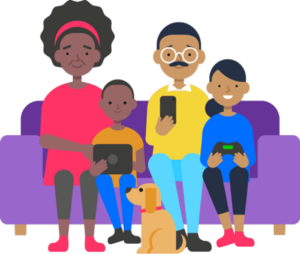Children’s safety online is the issue most important to us at Internet Matters. In this blog we explore a topic that plays an important role in digital safety: parental controls.
Introduction
While parental controls aren’t a silver bullet, they can be useful in helping parents support children online. But how far are parents aware of the safety tools available to them, and how are they being used?
We are using data from our June 2023 parent and child trackers, where we talk to 2,000 parents with children aged 4-16 nationally representative of the UK, and 1,000 children aged 9-16.
Summary of findings
- There remains a lack of parental awareness of online safety tools: Currently, parents’ knowledge of online safety tools varies, with broadband parental controls being the most well-known. However, for other tools, awareness levels are only about half or less among parents. This points to the need for a more concerted effort to raise awareness of online safety tools.
- Awareness does not always translate into usage: Awareness is not enough – parents also need to make use of these tools. Approximately four out of five parents use at least one technical tool or control to manage their child’s online content access, but the average number of tools used remains under two. This indicates that many parents are not utilising the full range of safety tools available to protect their families.
- Children with parents who set up parental controls talk to them more about digital safety: Nearly two thirds of parents who set up parental controls have talked about digital safety with their child in the past month compared to just a quarter of parents who haven’t set up parental controls. We know from previous research that dialogue in households about online safety leads to safer homes and better wellbeing overall, so the setting up of parental controls is an important consideration.
- Parents setting up parental controls report higher levels of online harms, but are more confident in dealing with them: parents who stated they set up parental control settings on devices in the home reported a higher level of online harms being experienced by their children compared to parents who haven’t set up controls. This group also has a higher level of understanding and confidence in dealing with online issues so will be more adept at seeing when online harms occur and what to do about them when they do.
Exploring parents’ relationships with parental controls
As set out in our resources, parental controls are the names for a group of settings that give parents greater control over the content their children see online. Combined with privacy settings, they can help parents protect children from inappropriate content, online grooming, abuse and trolling, and other online safety issues.
This blog explores parents’ relationships with parental controls. Using evidence from our tracker, it set out:
- Levels of awareness and usage of parental controls, and possible explanations for these findings
- Differences by group; and
- The perceived impact of parental controls on talking about online safety in the home.
Levels of awareness and usage
We asked parents of children aged 4-16 about whether they were aware of different types of parental controls and if so, whether they used them. This data allows us to estimate which tools are being more or less used, and to understand where there is a drop off from awareness to actual usage.
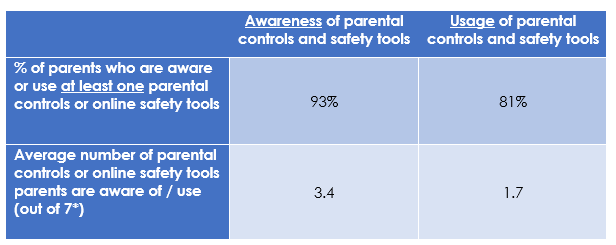
In positive news, a large majority of parents (93%) are aware of at least one type of parental control. In fact, parents are aware of an average of three of the parental control types. However, our list referred to a total of seven different types of parental controls, and only 12% were aware of all of these, with an average of 1.7 parental controls or safety tools being used by parents out of the list of seven being tested. This suggests that there is more work to do to ensure that parents are aware of the full range of tools available to them in this space.
Moving on to usage, there is again a positive story in some respects: around 4 in 5 parents use at least parental control (81%). But that means that nearly one in five parents (19%) who are aware of controls do not make use of them, or only a minority of them.
Looking at which types of parental controls are most popular (figure 1 below), broadband parental controls have both the highest awareness levels (63% of parents are aware of them) and the highest usage levels (34%). More than half of parents are also aware of screen time management apps, gaming console controls and streaming and search safety settings, but less than a third of parents use them.
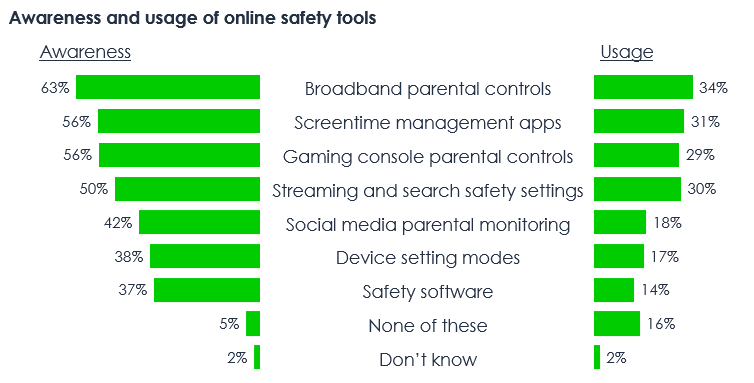
The largest drop off from awareness to actual usage is seen amongst Safety software (e.g. Net Nanny, McAfee Family, Norton Family, Circle) from 37% of parents being aware and 15% usage (59% decrease). Perhaps in part due to the expense associated to setting these up compared to in-app/platform accessible safety features. Social media parental monitoring (e.g. Snapchat Family Centre, TikTok Family Pairing, Instagram parental supervision) also had a high drop off with a 54% decrease from 42% awareness and 19% usage. Below we go on to explore the reasons why parents aren’t setting up these tools.
Exploring who does and doesn’t use parental controls
Looking further into which parents use these controls, a significant difference is seen in relation to the age of their children. 86% of parents with under 11s have used at least one parental control setting, whilst 72% of parents with 15-16 year olds have. This aligns to other data we see in the tracker that with age, parents take a less active role in the digital safety of their child as they get older, typically from the age around 15.
Our survey asked parents who did not use any controls for their reasons. The dominant reason selected was that they didn’t feel that they needed them (53%).

This again points to the significance of the age of the child, with 69% of parents of 15-16 saying they don’t feel they need them. Several parents mentioned that they have a good relationship with their child and a good understanding of their digital habits, so didn’t feel the need to use parental controls.
Exploring the correlation between parents using parental controls and talking about online safety with their children
Our tracker asks children whether their parents use parental controls on devices and technology in the home, and we can use this data to compare the experiences of those who say yes and those who say no. From the point of view of children, parents who do set up parental controls on devices or apps also speak to children about online safety more regularly. 65% of children who said their parents have set up parental controls have spoken to them about online safety in the past month, compared to 26% of children who said their parents haven’t set up any rules about online safety.
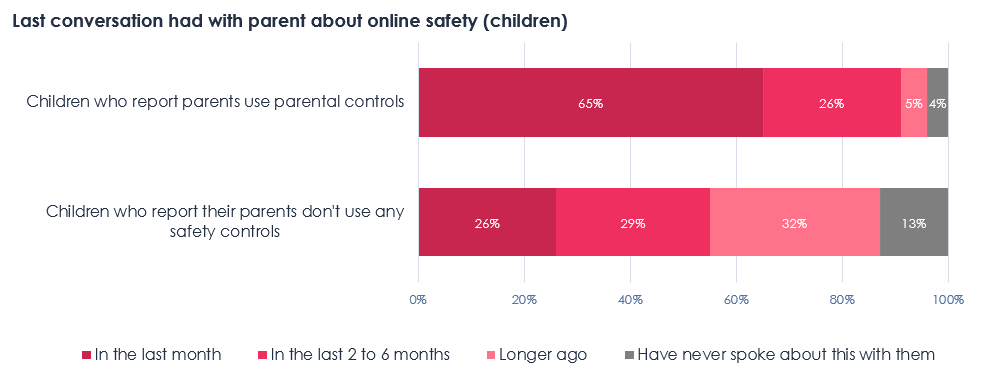
Figure 3 When was the last time you talked to your parents / guardian about what you do online, including online safety, if ever? Base: Total N-1,000, Parents use PCs n-508, Don’t use any n-82
Previous research has shown that those that talk with their child more regularly about digital safety have greater confidence in dealing with not only issues that occur but also in preventing them in the first place. We’ll now look at the link between children experiencing online harms and parental controls being set up.
Linking of online harms and parental controls
In our trackers, we collect data around the experience of online harms from both the perspective of parents reporting on behalf of their children, and from children directly. When looking at those parents who have stated they have set up parental controls, and those that have not, we can see an interesting difference in the extent of online harms that are being experienced by their child.
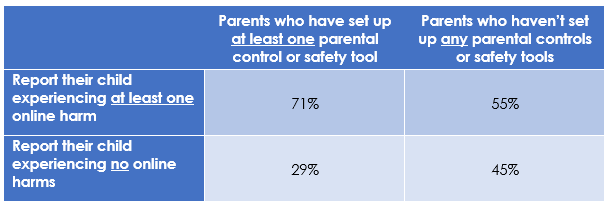
These are interesting results, as we would expect that those with parental control settings set up would experience fewer harms over more. What we can interpret from this is that those parents who are setting up safety controls are more engaged in digital safety and can therefore pick out when online harms occur. Amongst parents setting up safety controls, 74% stated they were confident at keeping their child safe online compared to just 61% amongst parents who haven’t set up controls. Therefore, we can assume that those setting up controls are more confident in dealing with issues and therefore better understand how to do this, primarily through setting up parental controls and other safety tools on devices in the home. For those not setting up controls, there is an education shortfall about digital safety and the reasons for that will be varied. But this group will need more support and guidance as to why parental controls can be helpful.
Concluding thoughts
Parental controls are an important part of the solution in helping children to stay safe online. The evidence presented in this blog shows:
- There is more work to do to drive up awareness and usage of the full range of parental controls.
- Not all parents are seeing the value of these tools, especially parents of older children. Is this because parental controls are not designed with older children in mind? Or is it linked to the more general challenge of parents not understanding the importance of their role as children grow older? It is likely a combination of both. Often parents see online safety as something they need to talk to younger children about but not their older children – yet the evidence shows that older children suffer harm online, and need and value support. Parental controls are often about limiting children’s exposure to content but without explaining why, which may seem less appropriate to parents of older children.
- It’s not either/or – some parents use parental controls as part of a wider strategy to support their children online, which also includes having conversations with their children. Our wider experience at Internet Matters points to the value in this approach – parental controls cannot be relied upon in isolation, and are most effective when children feel on board with their use.
For more information about parental controls, including support on how to set them up, please explore our parental controls guides.






